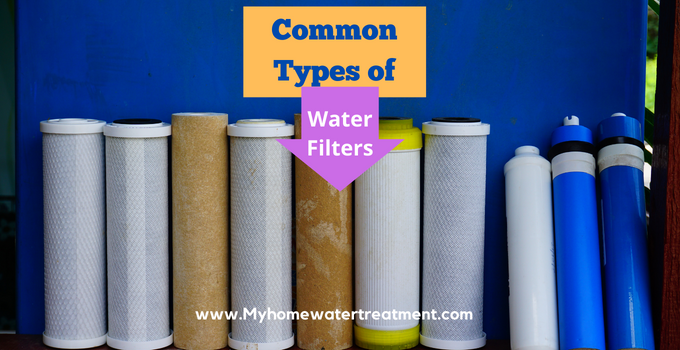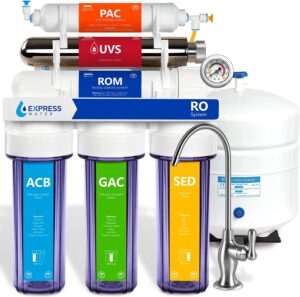Water can be contaminated from different sources before being used. A water filter is able to remove water impurities using a physical barrier, through a chemical or a biological process. In many occasions, water is filtered to provide:

Table of Contents
Some Features: Common Types Of Water Filters
- Clean drinking water
- Agricultural water for irrigation
- Safe water for use in ponds and swimming pools
- Clean water for aquariums
To understand the water filtration process, you need to have an idea about the Common Types of filters used. They include:
Ultraviolet (UV) filters
With the developments in technology today, UV filters are the most advanced filters on the market today. The filters are very effective in killing bacteria, viruses and other disease-causing microorganisms that maybe found in water.
The system works by passing the water to be treated through a chamber which has a UV light; the light shines through the water that is passing through the unit, thereby destroying the DNA cells of pathogens. This method is ideal for use because it is environmentally friendly. The method does not involve the use of chemicals, which might later affect the surroundings.
Water ionizers filters
Water ionizers are electrically powered systems that are attached to a standard faucet for the water filtration process. The system first filters the water to remove impurities embedded, and then later ionizes the water by passing it through charged electrodes. One of the pros of this system is producing alkaline water. Alkaline water is the most preferred for home use because it is softer, and hence lathers easily with soap, and also it has low acidic levels that provide many health benefits.
Reverse osmosis filters
The system uses the principle of semi-permeability to remove water impurities for use. The system is very popular because it can remove all kinds of contaminants that can pose a danger to your health. In addition, these filters produce clear water with no odor because it passes through very tiny pores when being filtered.
The solutes (impurities) are retained on the pressurized side while the pure solvent passes to the other side. The membrane allows only molecules which are small sized to pass through, and not large-sized molecules. Naturally, molecules move from a region of higher concentration to a region of lower concentration across a semi-permeable membrane in osmosis.
However, in reverse osmosis, this is not the case because the process is reversed to filter water impurities. External pressure is applied to facilitate reversing the natural flow of solvent molecules, and hence, the name reverse osmosis. Since the mechanism used is straining by excluding molecules of large sizes, the process can have a very high efficiency in providing clean water for use.

Activated carbon filters
Activated carbon has an electro-positive charge that is added to it to make it attract water impurities and chemicals during water purification. Carbon is positively charged to attract the negatively charged ions to the surface of the carbon.
There are two types of activated carbon filters used: granular activated carbon (GAC), found in a granular form, which has a higher impurities removal ratio compared to powdered block carbon, which is in powdered form. There are two factors which determine the efficiency level of carbon activated filters:
- The amount of carbon used in the unit—The greater the amount, the higher the efficiency because impurities can be easily attracted to the carbon granules and vice versa
- The amount of time the contaminant is in contact with the carbon granules—The water should flow slowly to provide enough time for the impurities to be removed from the water. If the water flows out fast, some impurities might not get attracted to the carbon and may pass out as contaminants
Finally, activated carbon filters are rated according to the size of particles they are able to remove. The size is measured in microns where the range starts from 50-micron filters which are less effective because they have large sized pores. The 0.5-micron filters are the most effective as they have the smallest pores that do not allow impurities to pass through.
Infrared filters
This system is also based on the use of modern technology where infrared rays are used in removing water impurities. Just like the alkaline system, infrared filters also soften the water for use by man. This is very important when you are living in an area with hard water that has a high mineral content,which causes scum formation in boilers, and has teeth-coloring properties. The infrared method uses heat and light to produce infrared rays to be able to charge the water negatively in making it soft.
Also Read: 10 Best Reverse Osmosis Systems